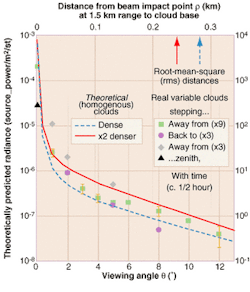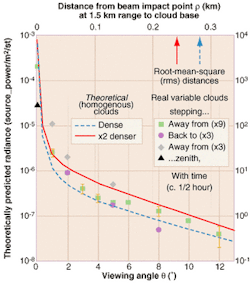Off-beam lidar senses cloud thickness and density
Clouds are a key component of the atmospheric environment because of their critical role in climate and in the hydrological cycle. It is therefore essential to reliably and cost-effectively monitor their physical properties. Data of interest include the clouds' altitude, thickness, density, particle size, and phase (whether the particles are liquid droplets or ice crystals), all of which vary over a wide range of scales, and not all of which are observable by the same means.
Cloud optics are also of interest in military and civilian aviation. Clouds are observed by ground-based and satellite instruments operating at wavelengths in the visible, near-infrared (NIR), thermal infrared (IR), and microwave regions. Each portion of the spectrum has its advantages and disadvantages in terms of what piece of cloud information is gained and at what accuracy. Each platform has an inherent trade-off in sampling versus resolution. All cloud remote sensing techniques are dependent on radiative transfer theory, including nontrivial scattering and absorption computations on single particles.
Passive techniques are by far the most common because they are easier to implement in hardware, especially in space. They are also the most prone to modeling error because clouds are, by definition, opaque and highly variable in their spatial structure and distribution. Much of this variability is unresolved and, even if it were resolved, is masked by the horizontal photon transport mediated by the multiple scattering. Active techniques are thus desirable and the two competing approaches are microwave radar (where clouds are generally semitransparent) and lidar (where dense low-level liquid clouds are opaque and high-level ice clouds are semitransparent). Because of the characteristic two-way transmission, tansparency (negligible extinction) is essential for most radar and lidar applications; semitransparency is tolerable (but retrieval error will increase); while opacity is a show-stopper.
This means that a standard lidar system is reduced to cloud-boundary detection—just the boundary on the same side as the device. This is called ceilometry when done from the ground. With some effort (polarization, multiple field of view), particle density, phase, and size can be determined—but only in the first layers. Microwave radar can in principle profile the cloud, but the slightest drizzle swamps the signal; there are other idiosyncratic artifacts to deal with, and, in the end, radar reflectivity has to be converted into more useful quantities for the radiation budget and hydrological cycle in the climate system. So, a potentially large modeling error looms.
Listening for the echo
A recent breakthrough occurred in cloud lidar observation that was suggested by advanced three-dimensional radiative transfer theory for sunlight, during research that was originally motivated by the Department of Energy's (DOE's) and NASA's existing programs in climate and remote sensing. The simple idea is to "listen" for the optical echo coming from all possible directions, not just along the transmitted beam. Indeed, typical visible/NIR laser wavelengths are not absorbed by air or water but are efficiently scattered by micron-sized interfaces such as cloud droplets, hence the familiar bright white appearance of the sunny sides of clouds. Thus, more than half the photons in a laser pulse are reflected in some way by the cloud, although generally not along the beam and generally not toward the source and observer's position. So, in the presence of dense clouds, there is a weak "off-beam" lidar signal waiting to be detected with the proper equipment.
Why attempt off-beam lidar? What important information about the cloud is physically encoded in the signal? To answer this question, we need a theory for the off-beam signal. It is clearly not based on the well-known radar and lidar equation that models a single backscattering event and a two-way transmission. Nor will the new theory be based on its modifications where multiple near-forward scatterings occur during the transmissions. The off-beam lidar equation is in fact based on photon-diffusion theory; that is, random-walk theory. More precisely, truncated random walks that start at a boundary and end either in diffuse transmission through the dense cloud or in equally diffuse reflection. This theory was not fully developed until the mid-1990s for the purposes of the previously mentioned Department of Energy and NASA programs.
Interestingly, the key results are related to the theoretical underpinnings of optical tomography techniques in nonintrusive medical diagnostics. We know that combinations of temporal and spatial off-beam signals enable the retrieval of cloud thickness and density, and possibly also an estimate of the degree of internal variability. These cloud properties are naturally averaged over the extent of the diffuse spot excited by the laser beam; this spot's dimension scales as the harmonic mean of the cloud thickness and the transport mean free path. So the effort is clearly worthwhile. How do we meet the technological challenges of off-beam signal detection?
The first measurement of an off-beam lidar signal in the field was done in 1996 at NASA's Goddard Space Flight Center (GSFC) using a ground-based research lidar instrument with relatively standard specifications. The transmitted 15-W, 1064-nm beam was progressively deflected away from zenith, leaving the receiver pointed vertically. Thanks to time integration and some pulse summation, the multiply-scattered signal was not lost into the solar and detector noise level until 12° off-zenith or, equivalently, 0.3 km from the beam impact at cloud base (see Fig. 1). Moreover, the predicted exponential decay in space was observed. Coincidentally, off-beam signal theory could be validated independently in the time domain using cloud returns from NASA's Lidar-In space Technology Experiment, which flew on the Space Shuttle in 1994.
FIGURE 1. Time-integrated spatial profiles of a reflected lidar spot show observations under real (hence variable) cloud cover and simulated signals for two idealized uniform clouds. The model clouds are 0.3 km thick; one is reasonably opaque (optical thickness 8), the other is twice as dense. The field observations were conducted at NASA-GSFC on the morning of Sept. 26, 1996. The log-linear axes demonstrate the exponential tails.
Since then, off-beam instrument development at Los Alamos National Laboratory evolved rapidly, thanks to a custom-built extremely sensitive focal-plane detector, the remote ultra-low-light imager (RULLI) that starts with a microchannel plate (MCP) and ends with fast electronics.1 This two-dimensional imaging solution gives us a first-hand measure of cloud variability. However, RULLI is so sensitive that it will easily saturate in the on- or near-beam field—which is still of interest. So we have had to use multiple exposures with combinations of neutral-density, spatial, and purposefully detuned interference filters to flatten the radiance field at the focal plane of a 60° field-of-view camera stopped down to ƒ/40+.
The next generation of off-beam lidar prototypes incorporate several upgrades. At Los Alamos, RULLI will be replaced with another MCP-based technology, a gated and intensified charge-coupled device better adapted to our needs. To acquire daytime capability, the 10-W solid-state Nd:YAG transmitter is being replaced by a comparably powerful dye laser tuned to one of the strong sodium doublet lines in the solar spectrum; the residual background can then be radically reduced with an ultranarrow magneto-optic filter with a bandpass of just a few picometers.2 Meanwhile, back at NASA-GSFC, a compact nonimaging system is being built for airborne deployment. At its focal plane, a massive bundle of optical fibers feeds ten photomultiplier tubes, performing azimuthal averaging in hardware. Alignment, however, is then critical to obtain the time-varying radial profile of the reflected spot segmented into eight exponentially increasing annuli (see Fig. 2). The largest annulus is divided into three azimuthal sectors, thus enabling an assessment of the cloud's nonuniformity.
FIGURE 2. Simulated off-beam returns for an eight-ring focal-plane configuration are calculated assuming airborne geometry: cloud top at 8.5 km range, 5º field of view. The cloud's optical depth is 15; it is assumed to be vertically stratified and horizontally uniform in extinction. The near-beam signal decays exponentially with a time scale on the order of the mean free path at cloud top. The off-beam signal decays more slowly, essentially on the scale of the cloud's thickness which was set to 0.5 km.
Off-beam techniques fulfill the fundamental goal of atmospheric lidar—namely, vertical profiling—when dense cloud layers roll in. Instruments with full diurnal-cycle coverage will soon replace current nighttime-only devices. We anticipate favorable comparisons with existing microwave profilers, especially since the retrieved cloud properties are directly relevant to the solar forcing of climate and weather with no further input from theory.
ANTHONY B. DAVIS and, STEVEN P. LOVE are technical staff members at Los Alamos National Laboratory, Bikini Atoll Road (Building 30) Los Alamos, NM 87545. ROBERT F. CAHALAN and MATTHEW J. McGILL are employed at NASA's Goddard Space Flight Center, Greenbelt, MD 20771; e-mail: [email protected].
REFERENCES
- W. C. Priedhorsky, R. C. Smith, and C. Ho, Appl. Opt. 35, 441 (1996)
- P. Yeh, Appl. Opt. 21, 2069 (1982).


